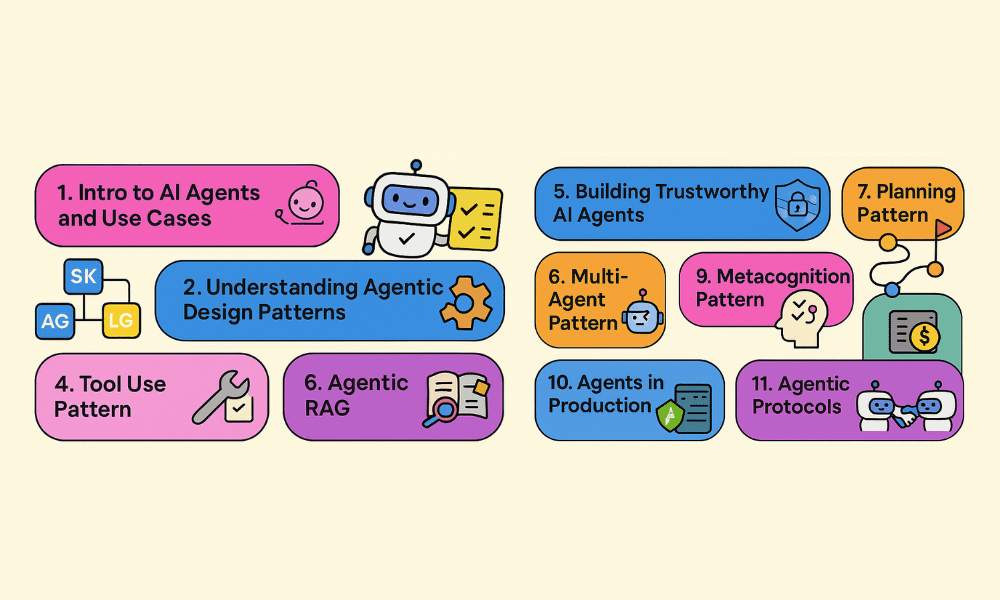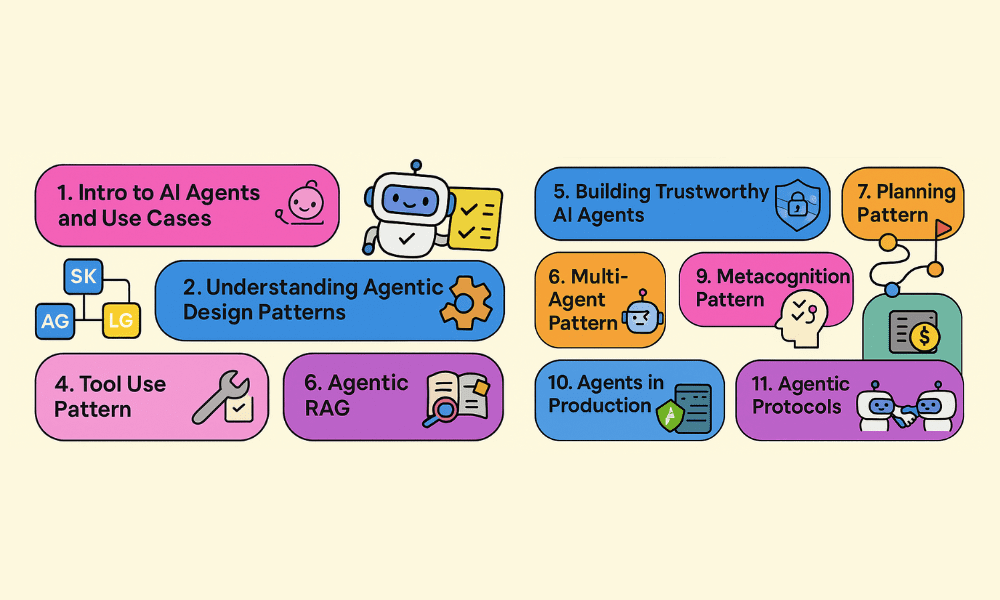Jobs & Careers
12 Essential Lessons for Building AI Agents


Image by Author | Canva & ChatGPT
# Introduction
GitHub has become the go-to platform for beginners eager to learn new programming languages, concepts, and skills. With the growing interest in agentic AI, the platform is increasingly showcasing real projects that focus on “agentic workflows,” making it an ideal environment to learn and build.
One notable resource is microsoft/ai-agents-for-beginners, which features a 12-lesson course covering the fundamentals of building AI agents. Each lesson is designed to stand on its own, allowing you to start at any point that suits your needs. This repository also offers multi-language support, ensuring broader accessibility for learners. Each lesson in this course includes code examples, which can be found in the code_samples folder.
Moreover, this course uses Azure AI Foundry and GitHub Model Catalogs for interacting with language models. It also incorporates several AI agent frameworks and services like Azure AI Agent Service, Semantic Kernel, and AutoGen.
To facilitate your decision-making process and provide a clear overview of what you will learn, we will review each lesson in detail. This guide serves as a helpful resource for beginners who might feel uncertain about choosing a starting point.
# 1. Intro to AI Agents and Agent Use Cases
This lesson introduces AI agents — systems powered by large language models (LLMs) that sense their environment, reason over tools and knowledge, and act — and surveys key agent types (simple/model-based reflex, goal/utility-based, learning, hierarchical, and multi-agent systems (MAS)) through travel-booking examples.
You will learn when to apply agents to open-ended, multi-step, and improvable tasks, and the foundational building blocks of agentic solutions: defining tools, actions, and behaviors.
# 2. Exploring AI Agentic Frameworks
This lesson explores AI agent frameworks with pre-built components and abstractions that let you prototype, iterate, and deploy agents faster by standardizing common challenges and boosting scalability and developer efficiency.
You will compare Microsoft AutoGen, Semantic Kernel, and the managed Azure AI Agent Service, and learn when to integrate with your existing Azure ecosystem versus using standalone tools.
# 3. Understanding AI Agentic Design Patterns
This lesson introduces AI agentic design principles, a human-centric user experience (UX) approach for building customer-focused agent experiences amid the inherent ambiguity of generative AI.
You will learn what the principles are, practical guidelines for applying them, and examples of their use, with an emphasis on agents that broaden and scale human capacities, fill knowledge gaps, facilitate collaboration, and help people become better versions of themselves through supportive, goal-aligned interactions.
# 4. Tool Use Design Pattern
This lesson introduces the tool-use design pattern, which allows LLM-powered agents to have controlled access to external tools such as functions and APIs, enabling them to take actions beyond just generating text.
You will learn about key use cases, including dynamic data retrieval, code execution, workflow automation, customer support integrations, and content generation/editing. Additionally, the lesson will cover the essential building blocks of this design pattern, such as well-defined tool schemas, routing and selection logic, execution sandboxing, memory and observations, and error handling (including timeout and retry mechanisms).
# 5. Agentic RAG
This lesson explains agentic retrieval-augmented generation (RAG), a multi-step retrieval-and-reasoning approach driven by large language models (LLMs). In this approach, the model plans actions, alternates between tool/function calls and structured outputs, evaluates results, refines queries, and repeats the process until achieving a satisfactory answer. It often uses a maker-checker loop to enhance correctness and recover from malformed queries.
You will learn about the situations where agentic RAG excels, particularly in correctness-first scenarios and extended tool-integrated workflows, such as API calls. Additionally, you will discover how taking ownership of the reasoning process and using iterative loops can enhance reliability and outcomes.
# 6. Building Trustworthy AI Agents
This lesson teaches you how to build trustworthy AI agents by designing a robust system message framework (meta prompts, basic prompts, and iterative refinement), enforcing security and privacy best practices, and delivering a quality user experience.
You will learn to identify and mitigate risks, such as prompt/goal injection, unauthorized system access, service overloading, knowledge-base poisoning, and cascading errors.
# 7. Planning Design Pattern
This lesson focuses on planning design for AI agents. Start by defining a clear overall goal and establishing success criteria. Then, break down complex tasks into ordered and manageable subtasks.
Use structured output formats to ensure reliable, machine-readable responses, and implement event-driven orchestration to address dynamic tasks and unexpected inputs. Equip agents with the appropriate tools and guidelines for when and how to use them.
Continuously evaluate the outcomes of the subtasks, measure performance, and iterate to improve the final results.
# 8. Multi-Agent Design Pattern
This lesson explains the multi-agent design pattern, which involves coordinating multiple specialized agents to collaborate toward a shared goal. This approach is particularly effective for complex, cross-domain, or parallelizable tasks that benefit from the division of labor and coordinated handoffs.
In this lesson, you will learn about the core building blocks of this design pattern: an orchestrator/controller, role-defined agents, shared memory/state, communication protocols, and routing/hand-off strategies, including sequential, concurrent, and group chat patterns.
# 9. Metacognition Design Pattern
This lesson introduces metacognition, which can be understood as “thinking about thinking,” for AI agents. Metacognition allows these agents to monitor their own reasoning processes, explain their decisions, and adapt based on feedback and past experiences.
You will learn planning and evaluation techniques, such as reflection, critique, and maker-checker patterns. These methods promote self-correction, help identify errors, and prevent endless reasoning loops. Additionally, these techniques will enhance transparency, improve the quality of reasoning, and support better adaptation and perception.
# 10. AI Agents in Production
This lesson demonstrates how to transform “black box” agents into “glass box” systems by implementing robust observability and evaluation techniques. You will model runs as traces (representing end-to-end tasks) and spans (petitions for specific steps involving language models or tools) using platforms like Langfuse and Azure AI Foundry. This approach will enable you to perform debugging and root-cause analysis, manage latency and costs, and conduct trust, safety, and compliance audits.
You will learn what aspects to evaluate, such as output quality, safety, tool-call success, latency, and costs, and apply strategies to enhance performance and effectiveness.
# 11. Using Agentic Protocols
This lesson introduces agentic protocols that standardize the ways AI agents connect and collaborate. We will explore three key protocols:
Model Context Protocol (MCP), which provides consistent, client-server access to tools, resources, and prompts, functioning as a “universal adapter” for context and capabilities.
Agent-to-Agent Protocol (A2A), which ensures secure, interoperable communication and task delegation between agents, complementing the MCP.
Natural Language Web Protocol (NLWeb), which enables natural-language interfaces for websites, allowing agents to discover and interact with web content.
In this lesson, you will learn about the purpose and benefits of each protocol, how they enable large language models (LLMs) to communicate with tools and other agents, and where each fits into larger architectures.
# 12. Context Engineering for AI Agents
This lesson introduces context engineering, which is the disciplined practice of providing agents with the right information, in the right format, and at the right time. This approach enables them to plan their next steps effectively, moving beyond one-time prompt writing.
You will learn how context engineering differs from prompt engineering, as it involves ongoing, dynamic curation rather than static instructions. Additionally, you will understand why strategies such as writing, selecting, compressing, and isolating information are essential for reliability, especially given the limitations of constrained context windows.
# Final Thoughts
This GitHub course provides everything you need to start building AI agents. It includes comprehensive lessons, short videos, and runnable Python code. You can explore topics in any order and run samples using GitHub Models (available for free) or Azure AI Foundry.
Additionally, you will have the opportunity to work with Microsoft’s Azure AI Agent Service, Semantic Kernel, and AutoGen. This course is community-driven and open source; contributions are welcome, issues are encouraged, and it is licensed for you to fork and extend.
Abid Ali Awan (@1abidaliawan) is a certified data scientist professional who loves building machine learning models. Currently, he is focusing on content creation and writing technical blogs on machine learning and data science technologies. Abid holds a Master’s degree in technology management and a bachelor’s degree in telecommunication engineering. His vision is to build an AI product using a graph neural network for students struggling with mental illness.
Jobs & Careers
DeepMind’s Demis Hassabis says calling AI PhD Intelligences is ‘Nonsense’

Demis Hassabis, CEO of Google DeepMind, dismissed claims that today’s AI systems are PhD intelligences, calling the label nonsense and arguing that current models lack the consistency and reasoning needed for true general intelligence.
“They’re not PhD intelligences,” Hassabis said in a recent All-in-podcast interview. “They have some capabilities that are PhD level, but they’re not in general capable, and that’s exactly what general intelligence should be—performing across the board at the PhD level.”
Hassabis’ statements come after OpenAI dubbed its latest AI model, GPT-5, as PhD-level.
Hassabis explained that while advanced language models can demonstrate impressive skills, they can also fail at simple problems. “As we all know, interacting with today’s chatbots, if you pose the question in a certain way, they can make simple mistakes with even high school maths and simple counting. That shouldn’t be possible for a true AGI system,” he said.
The DeepMind chief said artificial general intelligence (AGI) is still five to ten years away, pointing to missing capabilities such as continual learning and intuitive reasoning. “We are lacking consistency,” he said. “One of the things that separates a great scientist from a good scientist is creativity—the ability to spot patterns across subject areas. One day AI may be able to do this, but it doesn’t yet have the reasoning capabilities needed for such breakthroughs.”
On industry benchmarks, Hassabis pushed back against the idea of performance stagnation. “We’re not seeing that internally. We’re still seeing a huge rate of progress,” he said, countering reports that suggested convergence or slowing improvement among large language models.
Hassabis said that while scaling may deliver advances, one or two breakthroughs will still be required in the coming years.
Jobs & Careers
Databricks Invests in Naveen Rao’s New AI Hardware Startup

Ali Ghodsi, CEO and Co-Founder of Databricks, announced in a LinkedIn post on September 13 that the company is investing in a new AI hardware startup launched by Naveen Rao, former vice president of AI at Databricks.
Details of the company’s name, funding size, and product roadmap have not been disclosed yet.
“Over six months ago, Naveen Rao and I started discussing the potential to have a massive impact on the world of AI,” Ghodsi wrote. “Today, I’m excited to share that Naveen Rao is starting a company that I think has the potential to revolutionise the AI hardware space in fundamental ways.”
Rao, who previously founded Nervana (acquired by Intel) and MosaicML (acquired by Databricks), said the new project will focus on energy-efficient computing for AI.
“The new project is about rethinking the foundations of compute with respect to AI to build a new machine that is vastly more power efficient. Brain Scale Efficiency!” he said.
Ghodsi highlighted Rao’s track record in entrepreneurship and his contributions at Databricks. “If anyone can pull this off, it’s Naveen,” he noted, adding that Rao will continue advising Databricks while leading the new venture.
Databricks has closed a $10 billion Series J funding round, raising its valuation to $62 billion. The company’s revenue is approaching a $3 billion annual run rate, with forecasts indicating it could turn free cash flow positive by late 2024.
Growth is being fueled by strong adoption of the Databricks Data Intelligence Platform, which integrates generative AI accelerators. The platform is seeing rapid uptake across enterprises, positioning Databricks as one of the leading players in the enterprise AI stack.
Rao described the move as an example of Databricks supporting innovation in the AI ecosystem. “I’m very proud of all the work we did at Mosaic and Databricks and love to see how Databricks will be driving the frontier of AI in the enterprise,” he said.
Jobs & Careers
OpenAI Announces Grove, a Cohort for ‘Pre-Idea Individuals’ to Build in AI

OpenAI announced a new program called Grove on September 12, which is aimed at assisting technical talent at the very start of their journey in building startups and companies.
The ChatGPT maker says that it isn’t a traditional startup accelerator program, and offers ‘pre-idea’ individuals access to a dense talent network, which includes OpenAI’s researchers, and other resources to build their ideas in the AI space.
The program will begin with five weeks of content hosted in OpenAI’s headquarters in San Francisco, United States. This includes in-person workshops, weekly office hours, and mentorship with OpenAI’s leaders. The first Grove cohort will consist of approximately 15 participants, and OpenAI is recommending individuals from all domains and disciplines across various experience levels.
“In addition to technical support and community, participants will also have the opportunity to get hands-on with new OpenAI tools and models before general availability,” said OpenAI in the blog post.
Once the program is completed, the company says that participants will be able to explore opportunities to explore capital or pursue other avenues, internal or external to OpenAI. Interested applicants can fill out the form on OpenAI’s website by September 24.
Grove is in addition to other programs such as ‘Pioneers’ and ‘OpenAI for Startups’, which were announced earlier this year.
The OpenAI Pioneers program is an initiative that deploys AI to real-world use cases by assisting companies that intend to do so. OpenAI’s research teams will collaborate with these companies to solve the problems and expand their capabilities.
On the other hand, OpenAI for startups is an initiative designed to provide founders with AI tools, resources, and community support to scale their AI products. For instance, the program includes ‘live build hours’ where engineers from OpenAI provide hands-on demos, webinars, access to code repositories, ask me anything (AMA) sessions, case studies, and more.
It also includes real-life meetups, events, and more to assist founders in their journey. If startups are backed by venture capital firms that are partners of OpenAI (Thrive Capital, Sequoia, a16z, Kleiner Perkins, and Conviction Partners), they are eligible for free API credits, rate limit upgrades, and interactions with the company’s team members, alongside invites to exclusive events.
-

 Business2 weeks ago
Business2 weeks agoThe Guardian view on Trump and the Fed: independence is no substitute for accountability | Editorial
-
Tools & Platforms1 month ago
Building Trust in Military AI Starts with Opening the Black Box – War on the Rocks
-

 Ethics & Policy2 months ago
Ethics & Policy2 months agoSDAIA Supports Saudi Arabia’s Leadership in Shaping Global AI Ethics, Policy, and Research – وكالة الأنباء السعودية
-

 Events & Conferences4 months ago
Events & Conferences4 months agoJourney to 1000 models: Scaling Instagram’s recommendation system
-

 Jobs & Careers3 months ago
Jobs & Careers3 months agoMumbai-based Perplexity Alternative Has 60k+ Users Without Funding
-

 Podcasts & Talks2 months ago
Podcasts & Talks2 months agoHappy 4th of July! 🎆 Made with Veo 3 in Gemini
-

 Education2 months ago
Education2 months agoVEX Robotics launches AI-powered classroom robotics system
-

 Education2 months ago
Education2 months agoMacron says UK and France have duty to tackle illegal migration ‘with humanity, solidarity and firmness’ – UK politics live | Politics
-

 Podcasts & Talks2 months ago
Podcasts & Talks2 months agoOpenAI 🤝 @teamganassi
-

 Funding & Business3 months ago
Funding & Business3 months agoKayak and Expedia race to build AI travel agents that turn social posts into itineraries

